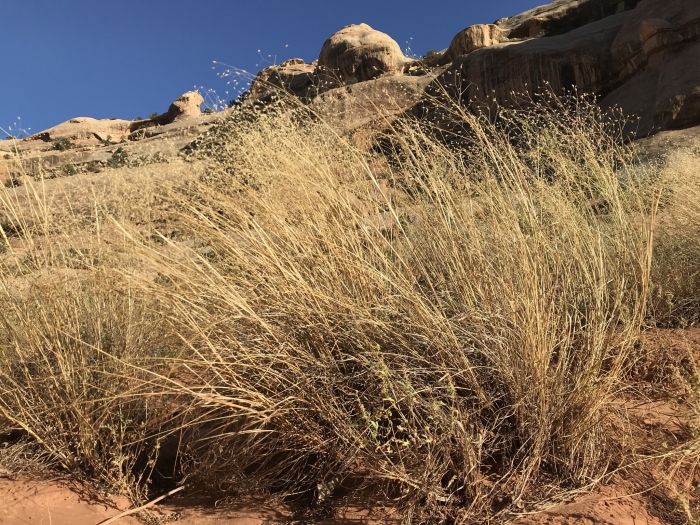Indian Ricegrass
(Eriocoma hymenoides)
Indian Ricegrass (Eriocoma hymenoides)
/
/

Robb Hannawacker
Public Domain
Image By:
Robb Hannawacker
Recorded By:
Copyright:
Public Domain
Copyright Notice:
Photo by: Robb Hannawacker | License Type: Public Domain | License URL: http://creativecommons.org/publicdomain/zero/1.0/ | Rights Holder: Robb Hannawacker | Publisher: iNaturalist | Date Created: 2019-10-01T23:30:10Z |



















































Estimated Native Range
Summary
Eriocoma hymenoides, commonly known as Indian Ricegrass, is a cool-season, perennial bunchgrass native to the western United States and Canada, where it thrives in arid environments such as deserts, sandy plains, and dunes. It is well adapted to infertile soils and can often be found in areas with low rainfall. Indian Ricegrass typically grows 4 to 24 inches (10 to 61 cm) tall and 8 to 12 inches (20 to 30 cm) wide, with narrow, rolled leaf blades and a tufted growth habit. This species is notable for its early spring growth, providing essential forage for wildlife and livestock when other food sources are scarce.
Indian Ricegrass is valued for its ability to stabilize soil and prevent erosion, making it an excellent choice for restoration projects and reclamation sites. Its ornamental qualities include delicate, airy seed heads that add texture to xeriscapes and naturalistic plantings. It is also used in low-water gardens due to its drought tolerance. This grass prefers full sun and can tolerate a range of soil types, provided they have good drainage. While it requires minimal maintenance, it is important to avoid overwatering. Indian Ricegrass is not typically associated with major diseases or pests, but it can become invasive outside its native range, so gardeners should consult local regulations before planting.CC BY-SA 4.0
Indian Ricegrass is valued for its ability to stabilize soil and prevent erosion, making it an excellent choice for restoration projects and reclamation sites. Its ornamental qualities include delicate, airy seed heads that add texture to xeriscapes and naturalistic plantings. It is also used in low-water gardens due to its drought tolerance. This grass prefers full sun and can tolerate a range of soil types, provided they have good drainage. While it requires minimal maintenance, it is important to avoid overwatering. Indian Ricegrass is not typically associated with major diseases or pests, but it can become invasive outside its native range, so gardeners should consult local regulations before planting.CC BY-SA 4.0
Plant Description
- Plant Type: Grass
- Height: 1-2 feet
- Width: 1-2 feet
- Growth Rate: Moderate
- Flower Color: N/A
- Flowering Season: Spring
- Leaf Retention: Deciduous
Growth Requirements
- Sun: Full Sun
- Water: Low
- Drainage: Medium, Fast
Common Uses
Bird Garden, Drought Tolerant, Erosion Control, Fire Resistant, Low Maintenance, Rock Garden, Street Planting
Natural Habitat
Native to arid environments such as deserts, sandy plains, and dunes in the western United States and Canada
Other Names
Common Names: Indian Millet, Sand Ricegrass, Sand Rice Grass
Scientific Names: , Achnatherum hymenoides, Oryzopsis hymenoides, Stipa hymenoides, Eriocoma hymenoides, Oryzopsis cuspidata, Eriocoma cuspidata, Oryzopsis membranacea, Fendleria rhynchelytroides, Eriocoma membranacea
GBIF Accepted Name: Eriocoma hymenoides (Roem. & Schult.) Rydb.